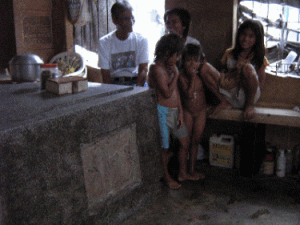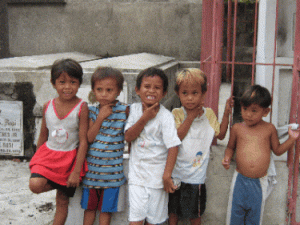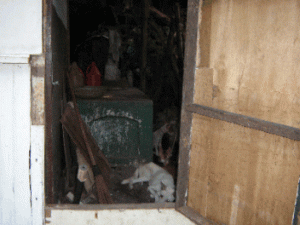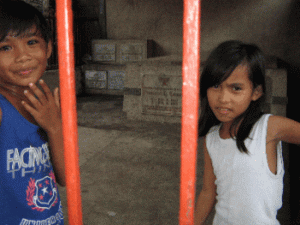When my friend, Father Max from Cebu, Philippines e-mailed to say: Reva, do you know that there are people who live in cemeteries? I was horrified. I’ve never heard of them, so I asked Fr. Max to write about them. The following is his write up.
An Article written by Fr. Max Abalos, SVD:
The celebration of All Saints and All Souls Days are the best days for all people living in the cemeteries and those whose survival depends on the cemetery. Practically, all cemeteries are fenced to prevent vandals, but this is not a strong deterrent against poor squatters from putting up shanties inside the graveyards. In Carreta Cemetery, right in the heart of Cebu City, there are approximately 30 families living inside the graveyard and another 30 families who go there everyday to earn a living. Carreta Cemetery is in between the two cemeteries: Chinese and Municipal Cemeteries. Business establishments surround the cemetery.
CARRETA CEMETERY, CEBU CITY (DWELLING PLACES INSIDE THE CEMETERY COMPOUND)

 This is Nora’s house and there are six (6) people living in here. They sleep like sardines.
This is Nora’s house and there are six (6) people living in here. They sleep like sardines.
Take note of the tombs at the ground.
The Municipal Cemetery on the other hand is located a few blocks from Carreta Cemetery going south. It is a public cemetery with no fence and seems to be disorderly. It is around 6 acres and congested, both for the living and the dead. It is normal that during the All Saints and All Souls’ Days celebrations, the house owners and the relatives of the dead whose tombs are squatted upon, would engage in verbal tussle because the tombs are no longer conducive for lighting candles and flower offerings. Their candles and flowers would end up in the big cross provided for those whose deceased relatives are not found or are not buried in the cemetery. The Municipal cemetery is a depressed community near the city abattoir. It is also known as habitués of thieves. There are around 500 families living there.
CARRETA CEMETERY, CEBU CITY
 Peding’s hearth beside at the tomb’s side
Peding’s hearth beside at the tomb’s side
The Chinese Cemetery is also located a few blocks from Carreta Cemetery. It is mainly the burial place for those of Chinese and Filipino-Chinese lineage. However, when memorial parks started sprouting in the city, the wealthy Chinese transferred the interment in the parks and only the poor Chinese are patronizing the necropolis. The cemetery dwellers there are around 100 families. This cemetery is also surrounded by slum colonies and is just walking distance from the biggest mall in Cebu City, using its exit – the ShoeMart.
CARRETA CEMETERY, CEBU CITY


The family of Diday making use of their backyard by raising livestock and planting vegetables
The families living in the three cemeteries are obviously living below the poverty line. They are all squatters in their own country. They came from slum colonies that were evicted by landowners, and since the government couldn’t give them decent places to stay, they found refuge inside the cemeteries. Many of them erected their makeshift huts on top of the tombs and some had enclosed the tombs with their housing structures. A number of them live inside mausoleums, which they maintain as hired cleaners. Many have lived there for at least 50 years. Many were born there and will probably die there, too. Understandably, they lack the basic facilities for proper hygiene and waste disposal. Their makeshift houses are made of light scrap materials and a number of them live in push carts. They have to buy their water from houses outside the cemeteries, and for light, they use the lamppost. It is quite a challenge for the children to study at night due to the absence of light.
CARRETA CEMETERY, CEBU CITY


home inside the mausoleum of Mayette’s family
The bamboo strips serve as the door of the family’s “house” along the rows of mausoleum
The cemeteries are teeming with children. Generally, both father and mother are working in the cemetery, either as grave diggers, candle and flower sellers, caretakers, prayer givers servicing for a fee, lapida (tomb marker) makers, etc. The children are also helping the parents augment their family income by cleaning the tombs for a fee and selling candles and flowers, especially on weekends when many people go the cemeteries. The family at times generates 100 pesos ($2) per day. This is not enough to feed a family of six with the high cost of living in the city. The people are happy when there is a burial because as the Cebuano custom dictates, the family of the dead would provide food to the funeral entourage. The cemetery dwellers will then join the crowd during the food distribution.
CARRETA CEMETERY, CEBU CITY


The family of Titing with Fr. Max Abalos, SVD. Both husband and wife are grave diggers
Leo and his baby son
Many of the children have difficulty pursuing education. Education in the elementary level is free; however, there are obligatory fees that are simply unaffordable to the poor. Secondary schooling and college education are expensive. Thus, according to research, out of 100 Filipino children who enrolled in grade 1, only 18 were able to proceed to high school and out of this, 4 graduated in college. The rest will drop out of which the notable reason is poverty. Formal education sponsorship will help these kids finish their secondary education and give them the chance to have better opportunities for employment and in engaging in self – help livelihood program or small scale entrepreneurship.
CARRETA CEMETERY, CEBU CITY


Children at play at the graveyard. The hairs are dyed just for fun by the adults.
Smiling faces in the midst of want
The Filipinos, due to poverty, strive so much to obtain education as their passport for economic salvation. Many parents would strive so hard to send their children to school with the hope that once they graduate, they will also help their younger siblings finish their schooling. Elder children feel responsible of taking care of their younger siblings, a trait that is commendable.
MUNICIPAL CEMETERY
 The houses of the living right on top of the resting place of the dead.
The houses of the living right on top of the resting place of the dead.
I [Fr. Max Abalos] belong to a charitable organization called ANCE, INC. – Action for Nurturing Children and Environment, Inc. (Philippines). ANCE, INC. was started in 1982 by a group of professionals who wanted to share the blessings they received from God through charitable deeds. The people behind ANCE, INC. commit to nurture, enhance, and protect the interests and well being of children and their families, especially the marginalized ones and its environs for a quality of life. They further strive to collaborate, coordinate and establish strong linkages with the different stakeholders to ensure that the children’s rights and welfare are adequately promoted and met and the integrity of creation fully protected and nurtured.
MUNICIPAL CEMETERY

 The tomb underneath the house reclaimed by the living
The tomb underneath the house reclaimed by the living
This is the house on top of the tomb shown above. Fr. Max in white shirt
The Vision of ANCE,INC.: A community of families who are economically self reliant and bonded by a strong and authentic sense of social responsibility towards each other and humankind and their environment anchored in faith in one Holy Triune God.
The folks at ANCE, INC. are now focusing their help to the people who live in the cemeteries.
MUNICIPAL CEMETERY
 Children at play
Children at play
Playing inside the mausoleum
To find out more about ANCE, INC., you may send an e-mail to: ance_inc@walla.com or visit our website:Here
The tombs are the children’s playground
Fr. Max with the family of Teresa